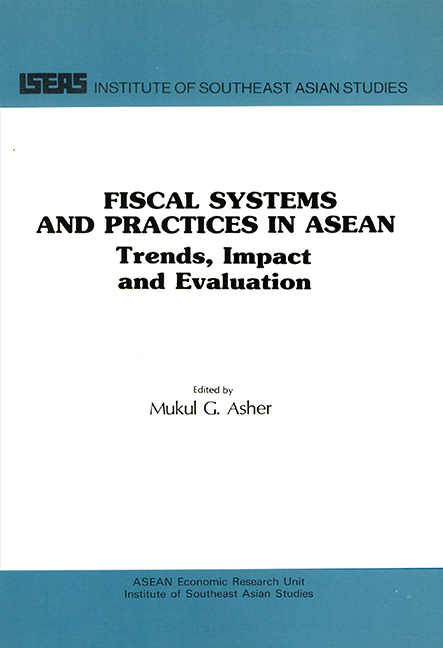Book contents
- Frontmatter
- Contents
- List of Tables
- List of Figures
- Acknowledgements
- 1 A Comparative Overview of ASEAN Fiscal Systems an Practices
- 2 Fiscal System and Practices in Indonesia
- 3 Fiscal System and Practices in Malaysia
- 4 Fiscal System and Practices in the Philippines
- 5 Fiscal System and Practices in Singapore
- 6 Fiscal System and Practices in Thailand
- THE EDITOR
3 - Fiscal System and Practices in Malaysia
Published online by Cambridge University Press: 21 October 2015
- Frontmatter
- Contents
- List of Tables
- List of Figures
- Acknowledgements
- 1 A Comparative Overview of ASEAN Fiscal Systems an Practices
- 2 Fiscal System and Practices in Indonesia
- 3 Fiscal System and Practices in Malaysia
- 4 Fiscal System and Practices in the Philippines
- 5 Fiscal System and Practices in Singapore
- 6 Fiscal System and Practices in Thailand
- THE EDITOR
Summary
Introduction
The public sector in Malaysia consists of the federal government, thirteen state governments, four municipalities (namely Penang, Ipoh, Kuala Lumpur and Malacca), non-financial public enterprises (NFPEs), and public financial institutions such as the Employee Provident Fund (EPF) and the Bumiputra Investment Foundation. As of September 1988, there were 847 government companies (including government financial institutions), with paid-up capital amounting to $19,652 million, of which the government contributed $13,819 million1 (Economic Report, 1988-89, p. 96).
The fiscal system of Malaysia operates under a federal structure. Under the Federal Constitution (10th schedule), the main revenue sources assigned to the states are receipts from land sales, revenue from lands, mines and forests, entertainment duty and Islamic religious revenue. Additional sources of revenue are assigned to the states of Sabah and Sarawak. These include import and excise duties on petroleum products and export duty on timber and other forest produce. The Constitution also provides for capitation and road grants to the states. In addition, special grants are provided to Sabah and Sarawak.
During the six years ending 1988, consolidated revenue of the thirteen states (excluding grants from the federal government) amounted to about one-sixth of the total revenue of the federal government. The operating expenditure of all the states combined increased steadily from 8.5 per cent of the operating expenditure of the federal government in 1983 to 22.5 per cent in 1988.
The quantitative importance of development expenditure of the NFPEs has been considerable. Thus, during the six years ending 1988, development expenditure by the NFPEs was about 70 per cent of such expenditure by the federal government.
In spite of the importance of the state governments and the NFPEs, this paper focuses on the fiscal system and practices of the federal government of Malaysia and their probable impact on resource allocation, incentives and growth, equity and stabilization.
- Type
- Chapter
- Information
- Fiscal System and Practices in ASEANTrends, Impact and Evaluation, pp. 63 - 102Publisher: ISEAS–Yusof Ishak InstitutePrint publication year: 1989



